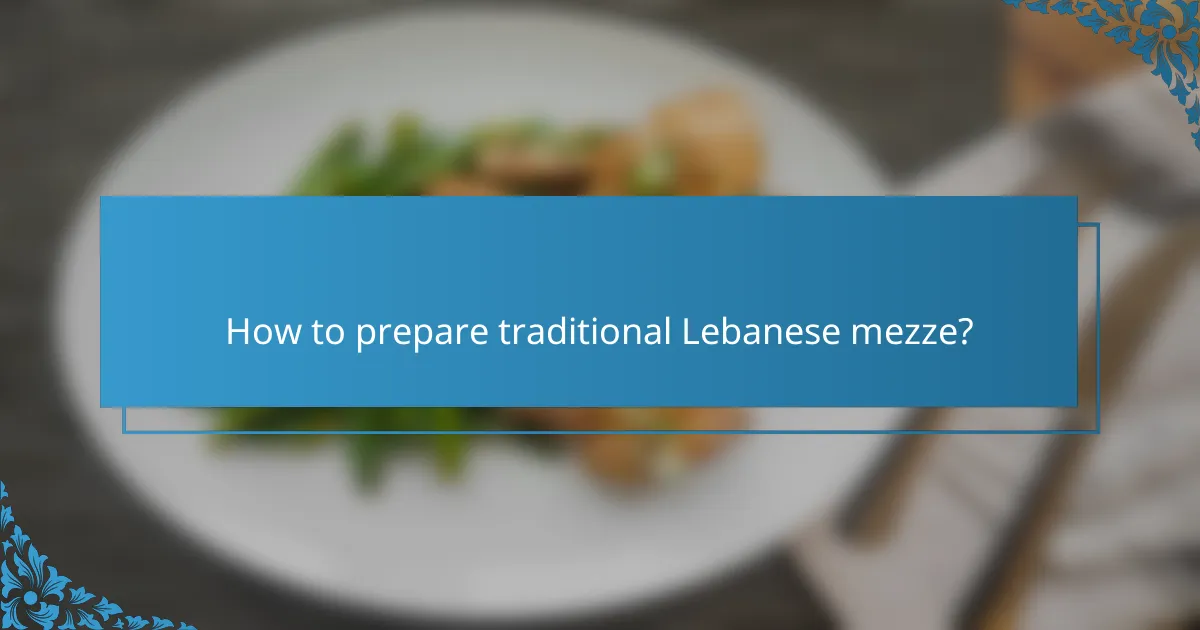Lebanese cuisine is a vibrant tapestry of flavors, deeply rooted in a rich history and a tradition of communal dining. Central to this culinary experience is mezze, a selection of small dishes that celebrate fresh herbs and ingredients, inviting diners to savor a variety of tastes. The use of aromatic herbs not only enhances the dishes but also offers numerous health benefits, making Lebanese food both delicious and nutritious.

What are the best Lebanese restaurants in Los Angeles?
Los Angeles boasts a vibrant Lebanese dining scene, featuring a variety of restaurants that showcase authentic flavors and traditional dishes. Some of the best Lebanese restaurants include Al-Masri, Lebanon Restaurant, and Marouch, each offering unique experiences and specialties.
Al-Masri Restaurant
Al-Masri Restaurant is known for its warm atmosphere and extensive menu that highlights classic Lebanese dishes. Diners can enjoy favorites like tabbouleh, hummus, and shawarma, all made with fresh ingredients and traditional recipes.
One of the standout features of Al-Masri is its commitment to using high-quality herbs and spices, which enhances the flavors of each dish. The restaurant also offers a selection of mezze, allowing guests to sample a variety of small plates, perfect for sharing.
Lebanon Restaurant
Lebanon Restaurant has been a staple in the Los Angeles Lebanese community for years, celebrated for its authentic cuisine and friendly service. The menu includes a range of options, from grilled meats to vegetarian dishes, catering to diverse dietary preferences.
Guests often rave about the restaurant’s signature dishes, such as kibbeh and baba ghanoush. The cozy setting makes it an ideal place for both casual dining and special occasions.
Marouch
Marouch stands out for its vibrant atmosphere and diverse menu, offering a mix of traditional and contemporary Lebanese dishes. Known for its generous portions, the restaurant is a popular choice for families and groups looking to enjoy a hearty meal.
Signature dishes at Marouch include their famous grilled kebabs and freshly baked pita bread. The restaurant also features a selection of Lebanese wines, enhancing the dining experience with local flavors.

How to prepare traditional Lebanese mezze?
Preparing traditional Lebanese mezze involves creating a variety of small dishes that are served as appetizers or snacks. These dishes highlight fresh ingredients, particularly herbs, and are often enjoyed in a communal setting.
Common mezze dishes
Some popular mezze dishes include hummus, baba ghanoush, tabbouleh, and falafel. Hummus is a creamy dip made from chickpeas, while baba ghanoush features roasted eggplant. Tabbouleh is a refreshing salad made with parsley, mint, and bulgur, and falafel consists of deep-fried chickpea patties.
Other notable mezze options are stuffed grape leaves (warak enab), spicy feta cheese dip (shanklish), and labneh, a strained yogurt that is often drizzled with olive oil. Each dish brings unique flavors and textures, making mezze a delightful experience.
Ingredients for mezze
The ingredients for mezze can vary widely but typically include fresh vegetables, legumes, grains, and herbs. Common staples are chickpeas, eggplants, parsley, mint, garlic, and olive oil. Spices such as cumin, sumac, and paprika are often used to enhance flavors.
For a basic mezze platter, consider including pita bread, olives, and a selection of dips. Fresh herbs are essential, as they add brightness and depth to the dishes. Aim for high-quality, fresh ingredients to achieve the best taste.
Step-by-step preparation
To prepare mezze, start by selecting your dishes and gathering all necessary ingredients. For dips like hummus and baba ghanoush, blend the main ingredients until smooth, adjusting seasoning to taste. For salads like tabbouleh, finely chop the herbs and mix with bulgur and dressing.
When serving, arrange the dishes on a large platter or individual plates. Offer pita bread and garnishes such as olives or pickles on the side. Mezze is best enjoyed fresh, so prepare just before serving to maintain flavor and texture.

What are the health benefits of fresh herbs in Lebanese cuisine?
Fresh herbs in Lebanese cuisine offer numerous health benefits, including enhanced flavor and nutritional value. They are rich in vitamins, antioxidants, and essential oils, which contribute to overall well-being.
Common herbs used
Lebanese cuisine features a variety of fresh herbs, with parsley, mint, and cilantro being among the most popular. Other commonly used herbs include dill, thyme, and basil, each adding unique flavors to dishes.
These herbs are often used in traditional mezze, salads, and main courses, highlighting their versatility in Lebanese cooking.
Nutritional benefits
Fresh herbs are low in calories but high in essential nutrients. For example, parsley is rich in vitamins A, C, and K, while mint aids digestion and has anti-inflammatory properties.
Incorporating these herbs into meals can boost the overall nutrient profile, providing antioxidants that help combat oxidative stress and support immune function.
Usage in dishes
Herbs are integral to many Lebanese dishes, often used in salads like tabbouleh or as garnishes for grilled meats. They can also be blended into dips such as baba ghanoush or served alongside pita bread.
To maximize flavor and health benefits, it is best to use fresh herbs rather than dried ones, as they retain more nutrients and provide a vibrant taste to the cuisine.

What is the history of Lebanese cuisine?
Lebanese cuisine has a rich history that reflects the diverse cultural influences on Lebanon over centuries. Its evolution is marked by the integration of various ingredients and cooking techniques, resulting in a vibrant culinary tradition known for its fresh herbs and mezze dishes.
Influences on Lebanese food
Lebanese food is shaped by a myriad of influences, including Mediterranean, Arab, and Ottoman cuisines. Each culture has contributed unique spices, cooking methods, and ingredients, such as the use of olive oil, garlic, and fresh vegetables. This blend creates a distinctive flavor profile that is both aromatic and diverse.
Additionally, the historical trade routes through Lebanon facilitated the exchange of culinary practices with neighboring regions, further enriching its food culture. Ingredients like za’atar and sumac are prime examples of this cross-cultural exchange.
Key historical events
Several key historical events have significantly impacted Lebanese cuisine. The Phoenician civilization, known for its maritime trade, introduced various spices and cooking techniques that laid the groundwork for modern Lebanese dishes. The Arab conquest in the 7th century brought new flavors and culinary traditions that integrated with local practices.
During the Ottoman Empire, Lebanese cuisine flourished as it absorbed influences from Turkish and Persian cuisines, leading to the creation of popular dishes such as kebabs and pilafs. The French mandate in the early 20th century also introduced new ingredients and cooking styles, further diversifying the culinary landscape.
Evolution of traditional dishes
The evolution of traditional Lebanese dishes showcases the adaptability of its cuisine. Mezze, a selection of small dishes served as appetizers, has become a staple, reflecting communal dining traditions. Dishes like tabbouleh and hummus have evolved over time, with variations in ingredients and preparation methods based on regional preferences.
Modern Lebanese chefs continue to innovate while respecting traditional recipes, often incorporating contemporary techniques and local produce. This blend of tradition and innovation ensures that Lebanese cuisine remains relevant and celebrated both locally and internationally.

What are the essential spices in Lebanese cooking?
Essential spices in Lebanese cooking include a variety of aromatic herbs and spices that enhance the rich flavors of the cuisine. Commonly used spices such as za’atar, sumac, and allspice create a distinctive taste profile that is integral to many traditional dishes.
Common spices
Lebanese cuisine features a range of common spices that are vital for its unique flavor. Za’atar, a blend of thyme, sesame seeds, and sumac, is often sprinkled on bread or used in marinades. Sumac adds a tangy, lemony flavor, while allspice provides warmth and depth to stews and meat dishes.
Other notable spices include cinnamon, which is used in both sweet and savory dishes, and cardamom, often found in coffee or desserts. Cumin and coriander are also prevalent, adding earthy notes to various recipes.
Flavor profiles
The flavor profiles in Lebanese cooking are characterized by a balance of fresh, tangy, and aromatic elements. The use of fresh herbs like parsley and mint complements the spices, creating a vibrant taste experience. The acidity from lemon juice and vinegar often enhances these flavors, making dishes refreshing.
Spices like allspice and cinnamon introduce warmth, while sumac and za’atar provide a zesty kick. This combination results in a complex layering of flavors that is both satisfying and invigorating.
Usage in recipes
In Lebanese recipes, spices are used strategically to build flavor. For instance, za’atar is commonly mixed with olive oil and spread on flatbreads, while sumac is often sprinkled over salads or grilled meats for added zest. Allspice is frequently included in dishes like kibbeh and stews, where it infuses the meat with a rich aroma.
When preparing Lebanese dishes, consider the balance of spices. Start with smaller amounts and adjust according to taste, as some spices can be quite potent. Experimenting with combinations can lead to delightful variations in traditional recipes.

How does Lebanese cuisine reflect cultural traditions?
Lebanese cuisine embodies cultural traditions through its use of fresh herbs, communal dining practices, and a rich history influenced by various civilizations. The emphasis on mezze, or small dishes, showcases the importance of sharing food as a social activity that fosters connection and celebration.
Role of food in celebrations
Food plays a central role in Lebanese celebrations, marking significant occasions such as weddings, religious holidays, and family gatherings. Traditional dishes like kibbeh, tabbouleh, and various mezze are often prepared in large quantities to accommodate guests and create a festive atmosphere.
During holidays like Eid and Christmas, families often come together to prepare special meals, reinforcing bonds and cultural identity. The act of sharing food during these times symbolizes unity and gratitude.
Family dining customs
Family dining in Lebanon is characterized by communal meals where dishes are placed in the center of the table for everyone to share. This practice encourages interaction and fosters a sense of togetherness, as family members engage in conversation while enjoying a variety of flavors.
Meals often start with mezze, which can include dips, salads, and grilled meats, allowing diners to sample multiple dishes. It is common for meals to last for hours, emphasizing the importance of leisure and connection over food.
Influence of religion
Religion significantly influences Lebanese cuisine, with various dietary laws and traditions shaping food practices. For instance, many Lebanese Muslims adhere to halal guidelines, while Christians may observe specific fasting periods that affect meal preparation and consumption.
Religious festivals often dictate the types of food prepared, such as the special sweets made during Ramadan or the traditional lamb dishes served during Easter. These culinary practices reflect the diverse religious landscape of Lebanon and its impact on cultural identity.
